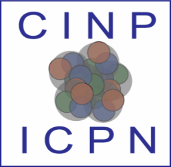The Key Questions in Nuclear Physics
The goal of nuclear physics research is to understand the origin, evolution and structure of visible matter in the universe. This is a far-reaching mission that requires a balanced program of experimental and theoretical efforts to address a number of key questions of significance to the larger scientific community. It is important to note that there is broad international consensus on these questions, as indicated by reports from the U.S. Nuclear Science Advisory Committee (NSAC) and the Nuclear Physics European Collaboration Committee (NuPECC). Here, we give a summary of these key questions and use them to place the Canadian nuclear physics effort in an international context.
1. How do quarks and gluons give rise to the properties of strongly interacting particles?
We know that hadrons, strongly-interacting composite particles such as protons, neutrons and pions, are made up of quarks and gluons, but we only have partial answers on how quarks are distributed and moving inside. Quantum Chromodynamics (QCD), the theory of the strong nuclear interaction between quarks and gluons, describes two regimes – the asymptotic freedom and confinement. While the discovery of asymptotic freedom within the context of perturbative QCD was recognized by the Nobel Prize in 2004, we still do not have a complete solution in the confinement regime, where the quark coupling strength is too large to allow the use of perturbative methods.
Thus, the explanation for the observed properties of the hadrons remains one of the central problems of modern physics, requiring advances in both theory and experiment. Recent advances in lattice QCD make it possible to extrapolate full lattice QCD simulations to physical quark masses, and thus allow direct comparison to experimental observables such as spectrum of hadrons. Further developments in computational methods making full use of new computing technologies and decisive breakthroughs are anticipated in the near future. In addition, the Chiral Perturbation Theory (ChPT), an effective field theory based on chiral symmetry of QCD, can provide stringent predictions of many fundamental properties of composite systems at low energies such as electromagnetic polarizabilities. Electromagnetic polarizabilities are fundamental properties of hadrons which are especially interesting because their values reflect dynamical response of hadrons to the electromagnetic probe at different energies, and their measurement provide an important test point for ChPT, dispersion relation approaches, and lattice QCD calculations.
Canadian theorists are major contributors to lattice calculations and to predictions based on ChPT and are closely working with experimentalists on planning the measurements and providing theory input, such as radiative corrections. Experiments designed to make detailed comparisons with QCD predictions are high-priority endeavours of research at facilities across the USA, Europe and Japan, with goals of obtaining: a tomographic view of the quarks and their motion within the nucleon; the elucidation of the role of gluons and gluon self-interactions in nucleons and nuclei; and a detailed understanding of how QCD governs the transitions of quarks and gluons into pions, protons and neutrons. Hadron spectroscopy has become even more exciting since evidence for new types of groupings in heavy-quark systems have been found: tetraquark and pentaquark, candidates in the charmonium sector, and hybrids in the light-quark sector probed in pion production.
Canadians have leadership roles in a number of experiments at offshore facilities, including detailed measurements of proton, kaon and pion structure, and investigations of the spectrum of hybrid mesons containing explicit gluonic degrees of freedom. For example, a Canadian group led experimental efforts at JLab to extract the photon-beam asymmetry for η and η 0 , resulting in a Ph.D. thesis and a publication [The GlueX Collaboration, S. Adhikari et al., Phys. Rev. C 100, 052201(R) (2019)]. The extracted beam asymmetry afforded comparisons to theoretical models, and indicated the dominance of natural parity exchange in the reaction mechanism.
2. What are the phases of strongly interacting matter, and what roles do they play in the cosmos?
Nuclei make up 99.9% of the visible matter in the universe. At the highest densities, yet at still rather low temperatures, the quarks making up the nucleons of nuclear matter may form a new state of matter, which is color-superconducting. Exotic nuclear matter can also be created by colliding nuclei at relativistic energies. In this case, ‘nuclear temperatures’ can reach values that represent a state of matter (the quark-gluon plasma) as it existed during the first moments after the Big Bang. This is an active field of study at international facilities such as RHIC in the USA, and the LHC at CERN. There are a number of very active Canadian theorists who are making significant contributions to our understanding of the phase diagram of nuclear matter (Fig 0). Their work has significant bearing on the quest to characterize the properties of the quark-gluon plasma, and for our understanding of astrophysical phenomena such as neutron star structure and the evolution of the early universe.
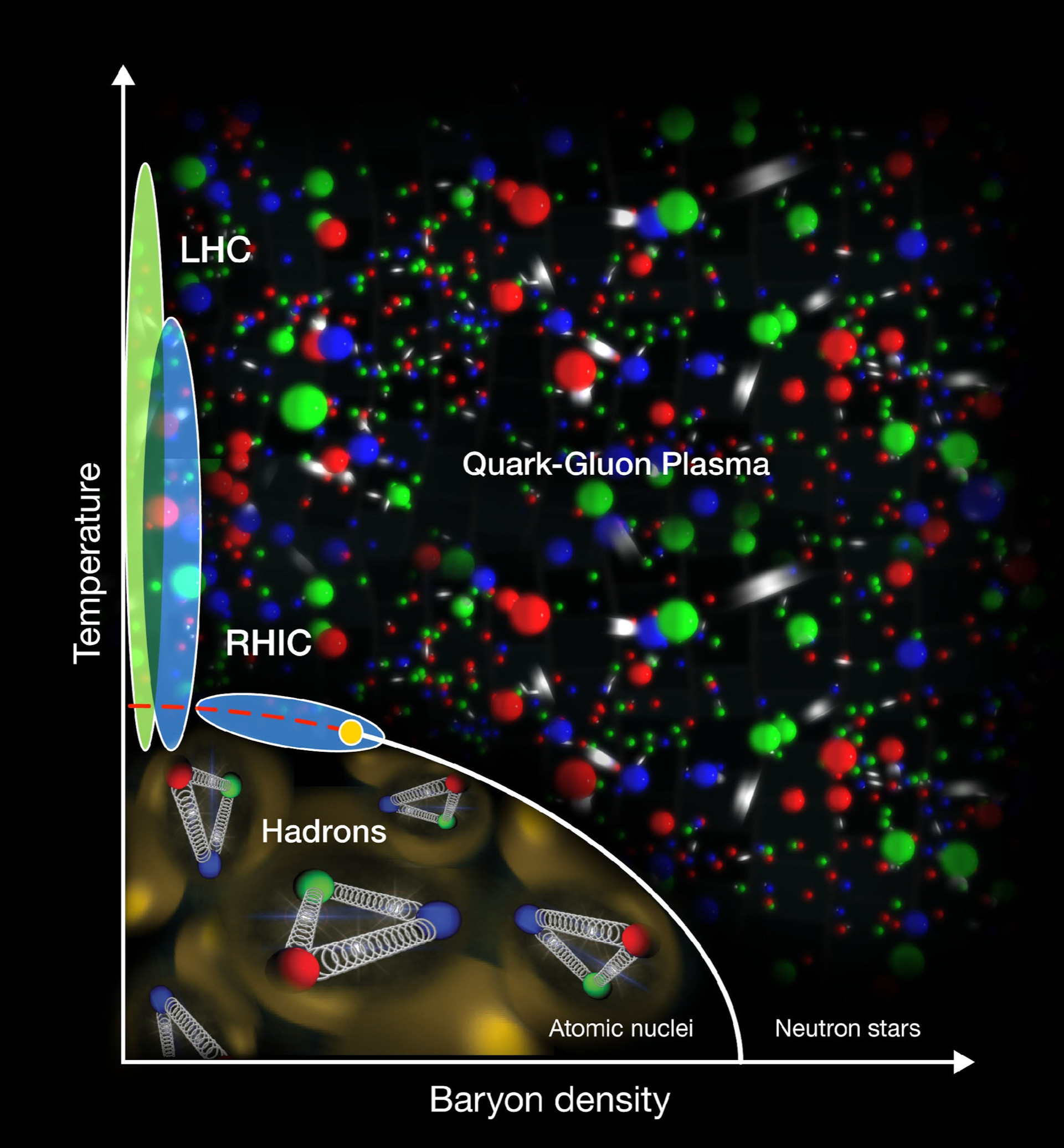
In recent years, the nuclear theory group at McGill University has developed and put forward a 3D, relativistic, viscous fluid-dynamical approach that has been successfully used to model the time-evolution of the high-energy nuclear collisions. A fundamental question in all studies of the many-body effects observed in high energy heavy ion collisions is whether the observed correlations develop dynamically or are already present in the initial states. A new approach has recently been constructed [Scott McDonald, Sangyong Jeon, Charles Gale. Nucl. Phys. A982 (2019) 239] which properly takes into account the the evolution in full 3-dimensional space. Importantly, the physics of the IP-Glasma relies on that of saturation: the scale at which the non-linearities of the gluon field manifest themselves. The exploration of the saturation regime is a central theme of the Electron-Ion Collider which will push our study of QCD to new frontiers.
3. How does the structure of nuclei emerge from nuclear forces?
Understanding the strong nuclear force binding the protons and neutrons to form the wide variety of complex nuclei in the universe has been a century-long challenge. Enormous progress has been made to this point, but it is a central pursuit of current nuclear structure research to reveal the fine details of the strong nuclear force that is responsible for the properties of nuclei and nuclear matter.
The rare isotopes are breaking the boundaries of our conventional knowledge and reforming our views on how nature organizes the building blocks, protons and neutrons, into a wide variety of complex atomic nuclei. Nuclear shells form the fundamental pillars that guide the characteristics of the atomic nucleus, influence the processes of element synthesis and are imprinted in the abundance of elements in nature.
Over the past decades it has been determined that the well-established nuclear shells that were identified in stable isotopes in the 1950’s, disappear in rare isotopes while new ones appear. This brings challenges to our understanding of nature’s strong force that is at the heart of existence of all visible matter. Associated with the changes in nuclear shells the rare isotopes manifest unexpected forms with the creation of a thick surface, called a neutron skin, in isotopes with large neutron-to-proton ratio. This predominant neutron surface provides us with laboratory access to understand neutron-dominated objects in the universe and find new features, such as new excitation modes, that arise from it. While a few discoveries with light nuclei have opened a new paradigm, much of the rare isotopes remain unexplored. Canadians have a unique opportunity to make substantive advances in this field through utilizing the world-leading capabilities of the TRIUMF-ISAC and ARIEL facilities for rare-isotope production as well as leveraging complementary opportunities at rare-isotope laboratories world-wide.
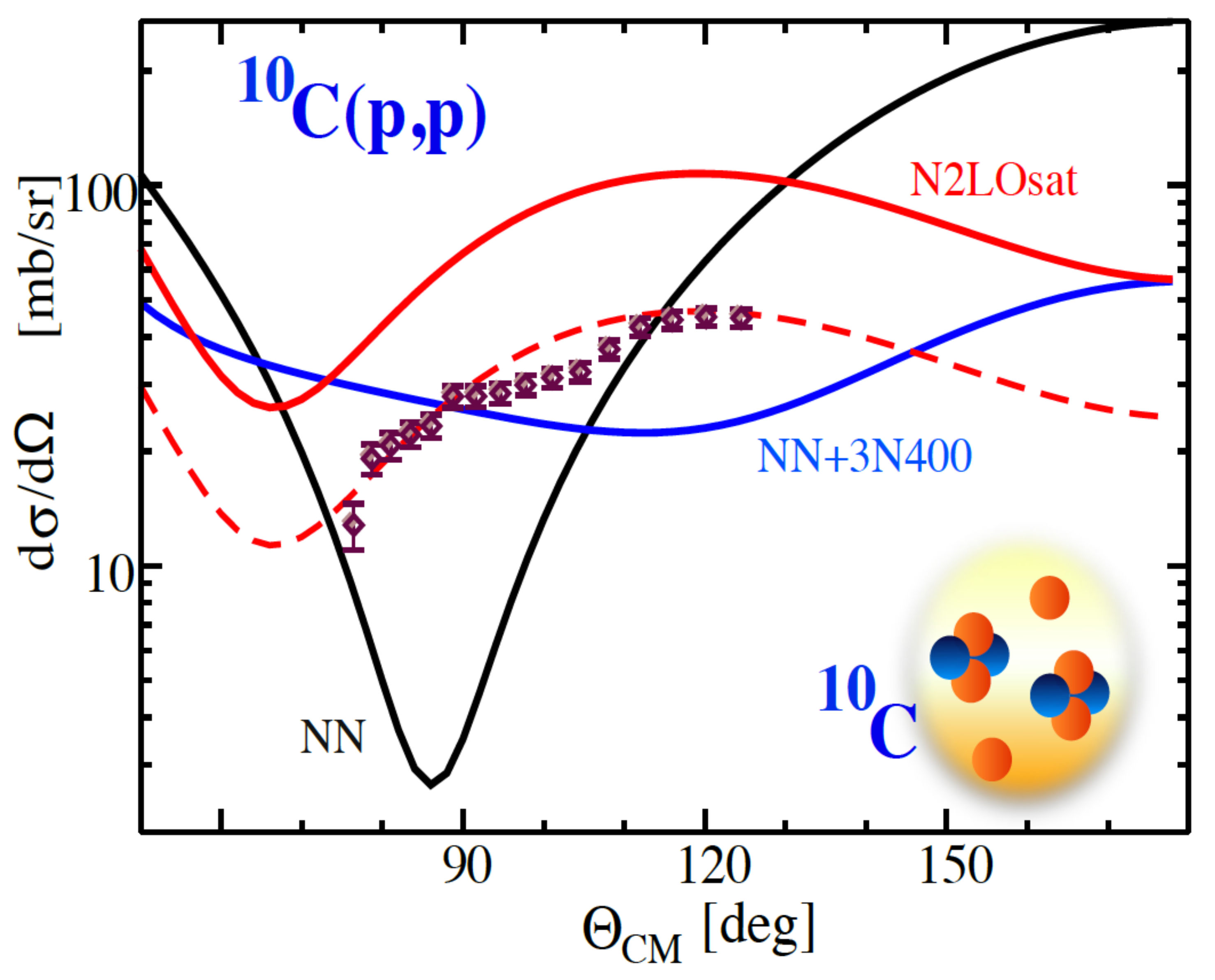
A recent highlight of the impact Canadian scientists are making is in revealing the imprints of the nuclear force in the elastic scattering of protons on 10-C. The chiral effective field theory enables a link for its description connected with the theory of quantum chromodynamics but requires certain parameters that are not uniquely defined. From a measurement of proton elastic scattering on 10-C using the IRIS facility at the TRIUMF-ISAC laboratory, and ab-initio nuclear reaction calculations performed by a collaboration led by the TRIUMF theory group, it was found that the shape and magnitude of the measured differential cross section is strongly sensitive to the nuclear force prescription (Fig 1).
4. What is the role of radioactive nuclei in shaping the visible matter in the universe?
Per aspera ad astra (”Through hardships to the stars”) - Lucius Annaeus Seneca, (4 BC–65 AD)
Nuclear astrophysics – connecting nuclear physics properties and the creation of nuclides in astrophysical events – has grown to a mature research field that connects many aspects of experimental and theoretical nuclear physics. The experimental tools are multifaceted, ranging from small accelerators installed at universities or even in underground laboratories to larger setups installed at radioactive beam facilities. With this variety of tools measurements of astrophysically relevant parameters are carried out.
The by far most important event for the nuclear astrophysics community in the last 5 years was the detection of the gravitational wave signal GW170817 from a binary neutron star merger, followed about 1.7 s later by a short γ-ray burst (GRB170817A). This triggered a world-wide unique effort that coined the term ”multi-messenger astronomy”, and about 11 h later the astronomical transient (AT2017gfo), a ”kilonova”, was under close observation by dozens of telescopes in various wavelengths from radio to X-rays 2 (see Fig. 2). Not surprisingly, the Nobel Prize in Physics 2017 went to the three key players of the LIGO/Virgo collaboration, Rainer Weiss, Barry C. Barish, and Kip S. Thorne ”for decisive contributions to the LIGO detector and the observation of gravitational waves”.
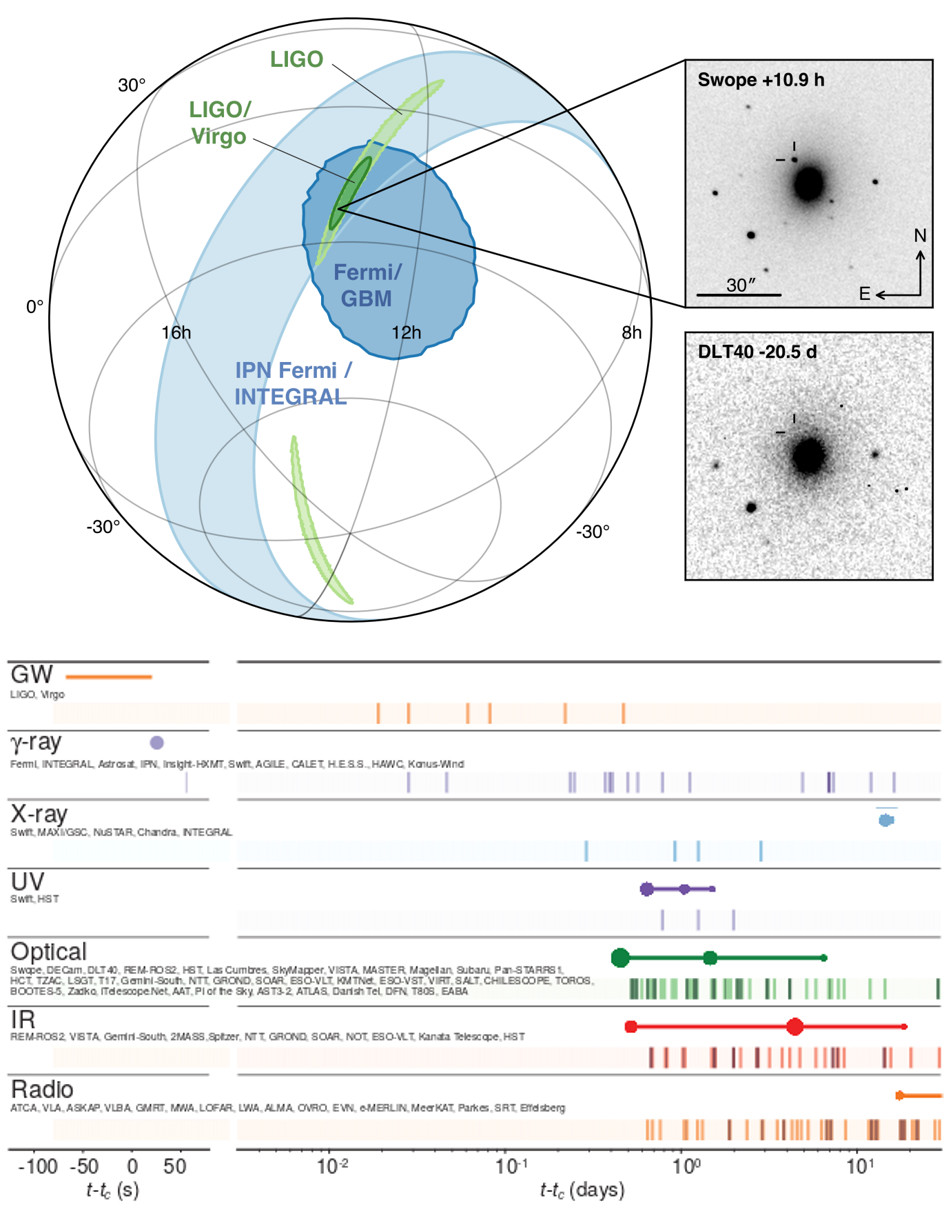
The event that triggered the gravitational wave emission on August 17th 2017 was identified as a merger of two neutron stars, a scenario that has never been observed before and is connected to the creation of about half of the elements heavier than iron in the so-called ”rapid neutron capture (r) process”. This astrophysical process is deeply connected to the nuclear physics of short-lived neutron-rich nuclei and the Equation of State (EoS) of neutron star matter, and was the prime motivation for the construction of the new generation of radioactive beam facilities worldwide, including the ARIEL facility at TRIUMF in Canada, as well as FRIB in the USA and FAIR in Germany.
A very successful ”multi-messenger nuclear (astro)physics” program is already being carried out at many facilities and universities, with the aim to better understand various aspects of the creation of nuclei in stellar events. The detection of GW170817 and all follow-up observations have now laid a firm foundation for a new highway to the interior of stars on which the Canadian Nuclear Astrophysics community is already moving since many years. The main focus of the experimental program will be the science enabled by the phased commissioning of the ARIEL facility, complemented by offshore experiments at radioactive beam facilities.
The experimental tools for the measurement of important nuclear properties of the nuclei, like reaction cross sections, decay half-lives, nuclear masses, and particle emission probabilities, have been developed and are waiting to be leveraged at this new generation of facilities. With ARIEL, the increase of available radioactive ion beamtime will not only allow the development of more beam species and more intense radioactive beams but also enable longer beamtimes to access more exotic nuclei and/or smaller cross sections which will greatly benefit the nuclear astrophysics program.
Reaction cross section measurements have been limited so far to nuclei close to stability. This limitation will be overcome in the next decade and open a new avenue for nuclear astrophysics. Specifically the indirect determination of neutron-induced cross sections of radioactive nuclei via surrogate methods like (d, p) reactions is an important extension to the ongoing efforts to measure proton- and α-induced cross sections at the DRAGON and EMMA recoil separator facilities, as well as with the smaller TUDA particle detector at TRIUMF.
The direct measurement of neutron-induced cross sections of short-lived nuclei might be still a bit down the road but first considerations for the world-wide unique coupling of a storage ring facility including an internal neutron generator target with radioactive beams from the ISAC facility are underway, and TRIUMF and the Canadian Nuclear Astrophysics community will play a pivotal 12role in this program in the next decade(s).
This experimental progress goes hand in hand with the tremendous progress on the nuclear theory side. Ab-initio, no-core shell model (NCSM), and valence space in-medium similarity renormalization group (VS-IMSRG) models for heavier nuclei have made a major step forward in the past years. Especially the VS-IMSRG model is a very promising tool since it extended the reach of ab-initio nuclear structure calculations to medium-mass nuclei, and in future will be able to go to heavier masses up to even the superheavy nuclei.
This decade will be the start of a new era of radioactive beam facilities that will help us push our understanding of the creation of the lightest up to the heaviest elements further than anytime before.
5. What physics lies beyond the Standard Model?
The Standard Model (SM) of Particle Physics is now half a century old, and in every way has been spectacularly successful. Its predictions have been confirmed over and over, as generations of increasingly sophisticated experiments in particle, nuclear, and atomic physics have pushed down the limits for possible deviations. At the “energy frontier” of this endeavour, collider physics has not observed any new particles beyond the Higgs, which gave closure to the SM. Neither have we found signatures of physics beyond the SM with rare meson decays or permanent electric dipole moments in atoms, to just name two methods with exquisite reach. Yet, there are extraordinarily compelling reasons to believe that the SM should not be the final answer: It does not explain dark matter nor dark energy, it gives no satisfying explanation for the extreme matter-antimatter asymmetry that we observe in our universe, and it has withstood all efforts to integrate a quantum theory of gravity, so far. In addition, aspects of the SM, while reproducing observations correctly, seem contrived, indicating that we lack deeper understanding. Why are the masses what they are? Why 3 generations of quarks and leptons? Why is only the weak interaction violating parity, why is this violation maximal, and CP violation seems unnaturally small? In addition, we only start to unravel the details of the neutrino sector. Clearly, we must press on to find answers to these fundamental questions.
Nuclear physics, and closely associated experiments in atomic and molecular (AMO) physics at the low-energy, precision, frontier, have played an important role all along in trying to answer these questions, complementary to high energy techniques. Advantages of this community are the diversity of efforts, nimble response to the changing landscape, relatively modest budgets, and diverse HQP training. Increasingly, a connection is forming to the emerging field of “quantum sensing”, or more broadly “quantum technology”, promising major gains in experimental sensitivity. Canada plays a distinguished role in the domain, with numerous efforts at two world-class domestic facilities, TRIUMF, and SNOLAB, as well as abroad, for example at JLab and CERN, covering most aspects of searches for physics beyond the SM. In the following we present some recent successes with Canadian involvement.
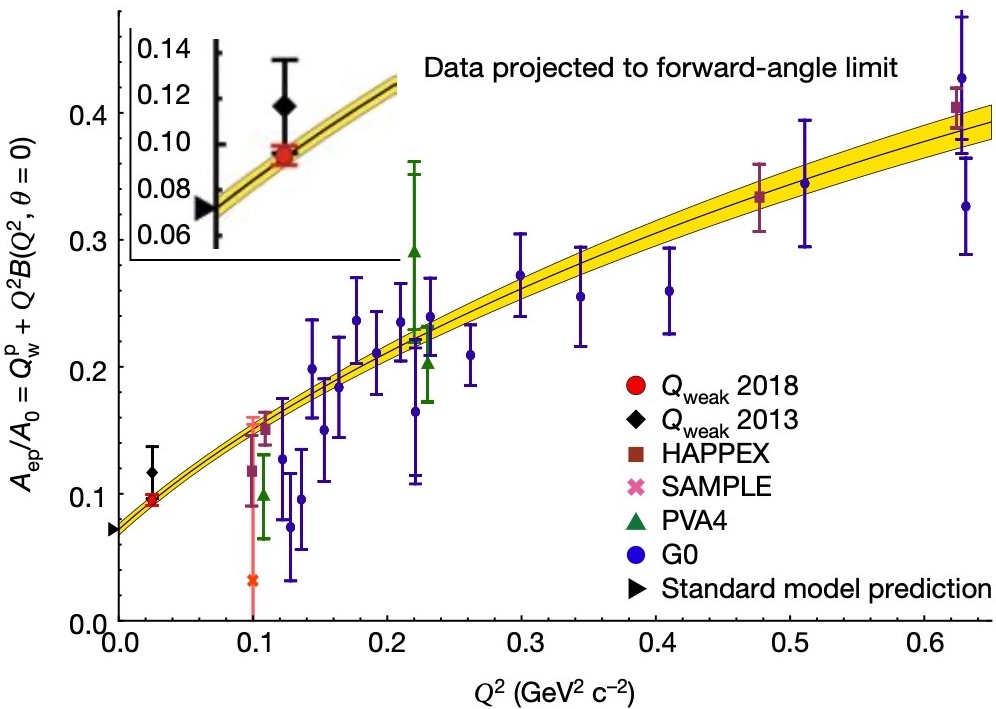
The Qweak collaboration published its final result for the weak charge of the proton, 0.0719 ± 0.0045, derived from the parity-violating asymmetry in the scattering of polarized electrons on protons, measured at the 9 ppb level (see Fig. 3). The result is in excellent agreement with the SM prediction, and sets multi-TeV-scale constraints on any semi-leptonic parity-violating physics not described within the SM. The tour-de-force nPDGamma effort concluded by reporting the first non-zero measurement of parity violation in the neutron-proton system 5 , and the n3He collaboration accomplished the same feat in the neutron- 3 He system 6 . The ALPHA anti-hydrogen effort produced a series of outstanding measurements. Amongst them, charge-neutrality of anti-hydrogen was confirmed at the 10E-9 level, the 1s − 2s transition frequency was measured to 10E-12, and laser cooling was demonstrated. The EXO-200 collaboration put a lower limit for the 0νββ lifetime of 136-Xe of 3.5 × 10E25 years, which is one of the most competitive measurements. EXO-200 was the first 100-kg class 0νββ detector and was decommissioned in 2018 after almost a decade of operation. The TRINAT atom trap facility at TRIUMF reported the best relative accuracy of any β asymmetry in a nucleus , with a 0.3 % measurement on laser-trapped and nuclear spin polarized sample of 37-K. The superallowed β decay team, amongst numerous improved branching ratios and lifetimes, carried out the first superallowed half-life measurement to better than 10E−4 , using 10-C. Teams involving theorists from Alberta and Manitoba refined calculations of radiative corrections in beta decay, opening up a 2 to 3 σ tension in CKM unitarity. The TUCAN collaboration reported the first production of ultra-cold neutrons at TRIUMF in 2017, and is on their way to start their neutron EDM experiment by 2023. The team built and commissioned a new fast kicker magnet serving a new proton beamline with a high-power spallation target. The FrPNC experiment at TRIUMF detected in 2018 for the first time the Stark-induced 7s − 8s transition in laser-trapped, atomic francium, preparing the ground for a parity violation experiment.
